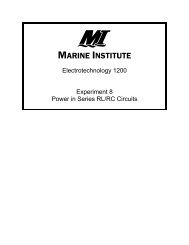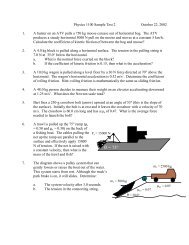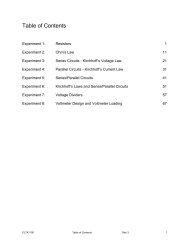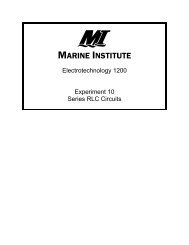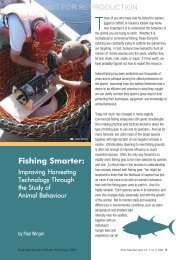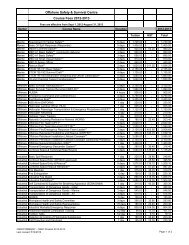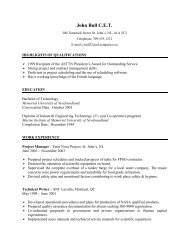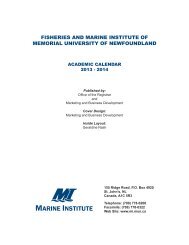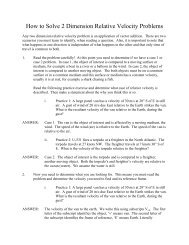Chemistry 1011
Chemistry 1011
Chemistry 1011
Create successful ePaper yourself
Turn your PDF publications into a flip-book with our unique Google optimized e-Paper software.
<strong>Chemistry</strong> <strong>1011</strong>TOPICAcids and BasesTEXT REFERENCEMasterton and Hurley Chapter 4.2 (Review), 13,14.1, 15.1 (page 427), 21.2 (page589)<strong>Chemistry</strong> <strong>1011</strong> Slot 5 1
13.6 Acid-Base Properties of SaltSolutionsYOU ARE EXPECTED TO BE ABLE TO:• Account for the acidity, basicity or neutrality of salts interms of the hydrolysis of cations and anions• Identify and apply the relationship between K a and K b(This section will include material contained in 13.4 and13.5 related to the acid-base properties of cations andanions)<strong>Chemistry</strong> <strong>1011</strong> Slot 5 2
Hydrolysis of Salts• All salts are strong electrolytes – this means thatthey are fully ionized in dilute aqueous solutionNaCl (s) Na + (aq) + Cl − (aq)CH 3 COONa (s) CH 3 COO − (aq) + Na + (aq)NH 4 Cl (s) NH 4+ (aq) + Cl − (aq)• If the salts are formed from either weak acids orbases, then their ions may react with water(hydrolysis)– NaCl is the salt of a strong acid and strong base–CH 3 COONa is the salt of a weak acid and a strong base–NH 4 Cl is the salt of a strong acid and a weak base<strong>Chemistry</strong> <strong>1011</strong> Slot 5 3
Hydrolysis of Salts• CH 3 COONa is the salt of a weak acid (acetic acid)and a strong base (sodium hydroxide).• The CH 3 COO − ions will react with water:CH 3 COO − (aq) + H 2 O (aq) CH 3 COOH (aq) + OH − (aq)• The CH 3 COO − ion is a Bronsted-Lowry base.The solution will be basic.K b = [CH 3 COOH] x[OH − ] = 5.6 x 10 −10[CH 3 COO − ]• Any anion derived from a weak acid will be aweak base<strong>Chemistry</strong> <strong>1011</strong> Slot 5 4
Hydrolysis of Salts• NH 4 Cl is the salt of a strong acid (hydrochloric acid)and a weak base (ammonia)• The NH 4+ ions will react with water:NH 4+ (aq) + H 2 O (aq) NH 3(aq) + H 3 O + (aq)• The NH 4+ ion is a Bronsted-Lowry acid. The solutionwill be acidic.K a = [NH 3 ] x[H 3 O + ] = 5.6 x 10 −10[NH 4+ ]• Any cation derived from a weak base will be a weakacid<strong>Chemistry</strong> <strong>1011</strong> Slot 5 5
Metal Cations as Weak Acids• Excluding Groups 1 and 2 (alkali metals and alkalineearths), many metal cations are weak acids– A 0.10mol/L solution of aluminum sulfate has a pH of ≈ 3– A 0.10mol/L solution of zinc nitrate has a pH of ≈ 5• These metal ions in solution are hydrated:–Al 3+ is [Al(H 2 O) 6 ] 3+–Zn 2+ is [Zn (H 2 O) 4 ] 2+• The hydrated ions act as Bronsted-Lowry acids:Al(H 2 O) 63+(aq) + H 2 O (aq) H 3 O + (aq) + Al(H 2 O) 5 (OH) 2+ ( aq)ca cb ca cb<strong>Chemistry</strong> <strong>1011</strong> Slot 5 6
Anions as Weak BasesBase K b pK bPO3− 4 2.2 x 10 −2 1.66CO2− 3 2.1 x 10 −4 3.68HPO2− 4 1.6 x 10 −7 6.80The larger the value of K b , the stronger the acidPO 43− (aq) + H 2 O (aq) HPO 42− (aq) + OH − (aq)• The PO 43−ion is a Bronsted-Lowry base. Thesolution will be basic.K b = [HPO 42−] x[OH − ] = 2.2 x 10 −2[PO 43−]<strong>Chemistry</strong> <strong>1011</strong> Slot 5 7
Relation between K a and K b• Ammonia in aqueous solution is basic:NH 3(aq) + H 2 O (aq) NH+ 4 (aq) + OH − (aq)K b = [NH 4+ ] x[OH − ] = 1.8 x 10 −5[NH 3 ]• The ammonium ion is its conjugate acid• We can write an equation for NH 4+ acting as anacid as:NH+ + 4 (aq) H 2 O (aq) NH 3(aq) + H 3 O + (aq)K a = [NH 3 ] x[H 3 O + ] = 5.6 x 10 −10[NH 4+ ]<strong>Chemistry</strong> <strong>1011</strong> Slot 5 8
Relation between K a and K b• Add the two equations:H 2 O (aq) + H 2 O (aq) H 3 O + (aq) + OH − (aq)• The equilibrium constant of the resulting equationis the product of the two equilibrium constants:K w = [H 3 O + ] x [OH − ] = K a x K b= (5.6 x 10 −10 ) x (1.8 x 10 −5 )= 1.0 x 10 −14• This relationship can be used to determine K b for aweak acid from a measurement of K a for itsconjugate acid, and vice versa<strong>Chemistry</strong> <strong>1011</strong> Slot 5 9
Relative Strengths of Bronsted-Lowry Acids and BasesK a Conjugate Acid Conjugate Base K bvery large HCl (strong acid) Cl − very smallH 3 O + H 2 O6.9 x 10 − 4 HF F − 1.4 x 10 − 111.8 x 10 − 5 CH 3 COOH CH 3 COO − 5.6 x 10 − 105.6 x 10 − 10 NH+4 NH 3 1.8 x 10 − 5H 2 O OH −very small OH − (strong base) O 2− very large<strong>Chemistry</strong> <strong>1011</strong> Slot 5 10
Relative Strengths of Acids and Bases• Bronsted-Lowry acids:– Strong acids - stronger proton donors than H 3 O +– Weak acids - weaker proton donors than H 3 O + but strongerthan H 2 O– Species that do not form acidic aqueous solutions• Bronsted-Lowry acids:– Strong bases - stronger proton acceptors than OH −– Weak bases - weaker proton acceptors than OH − but strongerthan H 2 O– Species that do not form basic aqueous solutions<strong>Chemistry</strong> <strong>1011</strong> Slot 5 11
Predicting Acid-Base Propertiesof Salts• What will be the effect of the cation on the pH of water?• Will the cation act as a weak acid or will it be a“spectator ion”– If this is a salt of a weak base, the cation will be a weak acid– If this is a salt of a strong base, the cation will be a “spectatorion”– If the cation is a hydrated metal ion, the solution will be aweak acid– If the cation is a group 1 or 2 metal ion, the cation will be a“spectator ion”<strong>Chemistry</strong> <strong>1011</strong> Slot 5 12
Predicting Acid-Base Propertiesof Salts• What will be the effect of the anion on the pH ofwater?• Will the anion act as a weak base or will it be a“spectator ion”– If this is a salt of a weak acid, the anion will be a weakbase– If this is a salt of a strong acid, the anion will be a“spectator ion”<strong>Chemistry</strong> <strong>1011</strong> Slot 5 13
Salts Formed by Reacting a WeakAcid with a Weak Base• To determine whether a salt of a weak acid andweak base will be basic or acidic, it is necessary tocompare the values of Ka and Kb to determinerelative strength– If Ka > Kb salt will be acidic– If Ka < Kb salt will be basic• eg: NH 4 F–K a NH 4+= 5.6 x 10 −10–K a F − = 1.4 x 10 −11– Solution has pH 6.2<strong>Chemistry</strong> <strong>1011</strong> Slot 5 14




